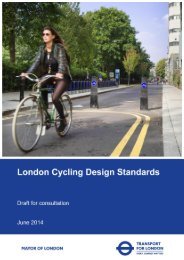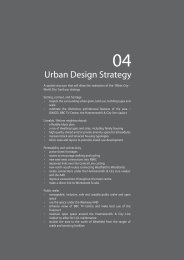Travel in London Travel in London
travel-in-london-report-8
travel-in-london-report-8
Create successful ePaper yourself
Turn your PDF publications into a flip-book with our unique Google optimized e-Paper software.
4. Performance of the transport networks<br />
Table 4.9<br />
Average traffic speeds (kilometres per hour) by functional sector of<br />
<strong>London</strong>. Work<strong>in</strong>g weekdays, by time period. TfL’s ‘network of <strong>in</strong>terest’.<br />
2008/09 vs. 2014/15.<br />
Area and<br />
time period<br />
2008/09<br />
average<br />
speed (18<br />
month<br />
period)<br />
2014/15<br />
average<br />
speed (18<br />
month<br />
period)<br />
% change<br />
Central AM<br />
peak<br />
Central<br />
<strong>in</strong>ter-peak<br />
Central PM<br />
peak<br />
Inner AM<br />
peak<br />
Inner <strong>in</strong>terpeak<br />
Inner PM<br />
peak<br />
Outer AM<br />
peak<br />
Outer <strong>in</strong>terpeak<br />
Outer PM<br />
peak<br />
14.7 14.1 -4%<br />
13.5 12.6 -7%<br />
14.4 13.1 -9%<br />
20.0 18.7 -6%<br />
21.1 20.3 -4%<br />
18.4 16.9 -8%<br />
31.5 29.4 -6%<br />
34.5 33.9 -2%<br />
29.9 27.4 -8%<br />
Source: TfL Surface Transport, Outcomes Delivery, based on data from Trafficmaster.<br />
Vehicle delay (congestion)<br />
Figure 4.6 shows the trend for congestion (delay), correspond<strong>in</strong>g directly to the<br />
average speed data <strong>in</strong> figure 4.5 above. Trafficmaster delay values are calculated<br />
aga<strong>in</strong>st a variable ‘uncongested’ night-time speed, which is that actually measured<br />
on a day-by-day basis, rather than a fixed nom<strong>in</strong>al ‘night-time’ speed, as was the<br />
case with previous mov<strong>in</strong>g car observer data. Furthermore, Trafficmaster<br />
‘uncongested’ speeds relate to the period from 22:00 to 06:00 – a period that, <strong>in</strong><br />
many parts of <strong>London</strong>, sees substantial volumes of traffic. Previous <strong>in</strong>dicators<br />
based on mov<strong>in</strong>g car observer data used a faster night-time speed.<br />
As well as the expected seasonal and geographical patterns shared with the speed<br />
data, figure 4.6 shows large differences <strong>in</strong> the degree of variability of traffic<br />
congestion by both area and time period. So, <strong>in</strong>ter-peak congestion <strong>in</strong> outer <strong>London</strong><br />
has historically rema<strong>in</strong>ed remarkably stable from month-to-month at about 0.5<br />
m<strong>in</strong>utes per kilometre, whereas morn<strong>in</strong>g peak congestion here may vary by up to<br />
100 per cent from month-to-month. In <strong>in</strong>ner <strong>London</strong> the degree of variation <strong>in</strong><br />
peak-period congestion is also roughly twice that of <strong>in</strong>ter-peak congestion. In<br />
central <strong>London</strong> the pattern is reversed – <strong>in</strong>ter-peak congestion be<strong>in</strong>g the most<br />
variable and this co<strong>in</strong>cid<strong>in</strong>g with the period of highest traffic demand on the<br />
network. This pattern is characteristic of networks where traffic demand rout<strong>in</strong>ely<br />
approaches the carry<strong>in</strong>g capacity of the network. Congestion, as a measure of<br />
89 <strong>Travel</strong> <strong>in</strong> <strong>London</strong>, Report 8








